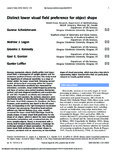Distinct lower visual field preference for object shape
| dc.contributor.author | KANG, JUNGHEE | |
| dc.contributor.author | Logan, AJ | |
| dc.contributor.author | Kennedy, GJ | |
| dc.contributor.author | Gordon, GE | |
| dc.contributor.author | Loffler, G | |
| dc.date.accessioned | 2017-11-16T17:37:21Z | |
| dc.date.available | 2017-11-16T17:37:21Z | |
| dc.date.issued | 2015-04-24 | |
| dc.identifier.issn | 1534-7362 | |
| dc.identifier.issn | 1534-7362 | |
| dc.identifier.other | ARTN 18 | |
| dc.identifier.uri | http://hdl.handle.net/10026.1/10193 | |
| dc.description.abstract |
Humans manipulate objects chiefly within their lower visual field, a consequence of upright posture and the anatomical position of hands and arms.This study tested the hypothesis of enhanced sensitivity to a range of stimuli within the lower visual field. Following current models of hierarchical processing within the ventral steam, discrimination sensitivity was measured for orientation, curvature, shape (radial frequency patterns), and faces at various para-central locations (horizontal, vertical, and main diagonal meridians) and eccentricities (5° and 10°). Peripheral sensitivity was isotropic for orientation and curvature. By contrast, observers were significantly better at discriminating shapes throughout the lower visual field compared to elsewhere. For faces, however, peak sensitivity was found in the left visual field, corresponding to the right hemispheric localization of human face processing. Presenting head outlines without any internal features (e.g., eyes, mouth) recovered the lower visual field advantage found for simple shapes. A lower visual field preference for the shape of an object, which is absent for more localized information (orientation and curvature) but also for more complex objects (faces), is inconsistent with a strictly feed-forward model and poses a challenge for multistage models of object perception. The distinct lower visual field preference for contour shapes is, however, consistent with an asymmetry at intermediate stages of visual processing, which may play a key role in representing object characteristics that are particularly relevant to visually guided actions. | |
| dc.format.extent | 18-18 | |
| dc.format.medium | ||
| dc.language | en | |
| dc.language.iso | eng | |
| dc.publisher | Association for Research in Vision and Ophthalmology (ARVO) | |
| dc.subject | orientation discrimination | |
| dc.subject | curvature discrimination | |
| dc.subject | peripheral vision | |
| dc.subject | spatial vision | |
| dc.subject | shape perception | |
| dc.subject | face perception | |
| dc.subject | vertical meridian asymmetry | |
| dc.subject | horizontal vertical anisotropy | |
| dc.title | Distinct lower visual field preference for object shape | |
| dc.type | journal-article | |
| dc.type | Journal Article | |
| plymouth.author-url | https://www.webofscience.com/api/gateway?GWVersion=2&SrcApp=PARTNER_APP&SrcAuth=LinksAMR&KeyUT=WOS:000355203800018&DestLinkType=FullRecord&DestApp=ALL_WOS&UsrCustomerID=11bb513d99f797142bcfeffcc58ea008 | |
| plymouth.issue | 5 | |
| plymouth.volume | 15 | |
| plymouth.publication-status | Published | |
| plymouth.journal | Journal of Vision | |
| dc.identifier.doi | 10.1167/15.5.18 | |
| plymouth.organisational-group | /Plymouth | |
| plymouth.organisational-group | /Plymouth/Faculty of Health | |
| plymouth.organisational-group | /Plymouth/Faculty of Health/School of Health Professions | |
| plymouth.organisational-group | /Plymouth/REF 2021 Researchers by UoA | |
| plymouth.organisational-group | /Plymouth/REF 2021 Researchers by UoA/UoA03 Allied Health Professions, Dentistry, Nursing and Pharmacy | |
| plymouth.organisational-group | /Plymouth/Research Groups | |
| plymouth.organisational-group | /Plymouth/Research Groups/Institute of Health and Community | |
| plymouth.organisational-group | /Plymouth/Users by role | |
| plymouth.organisational-group | /Plymouth/Users by role/Academics | |
| dc.publisher.place | United States | |
| dc.identifier.eissn | 1534-7362 | |
| dc.rights.embargoperiod | Not known | |
| rioxxterms.versionofrecord | 10.1167/15.5.18 | |
| rioxxterms.licenseref.uri | http://www.rioxx.net/licenses/all-rights-reserved | |
| rioxxterms.type | Journal Article/Review |


